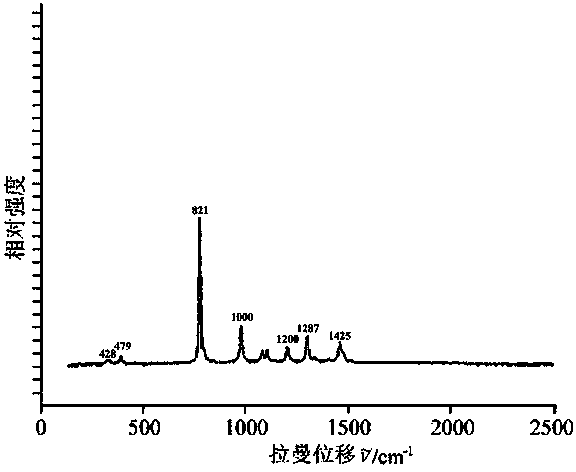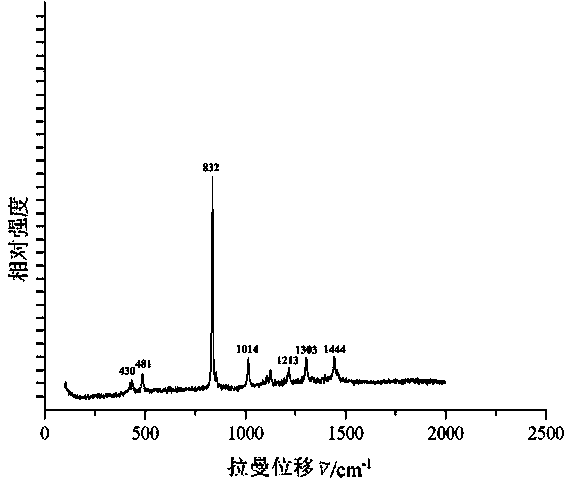Method for detecting content of dioxane in children cosmetics
A technology of dioxane and cosmetics, applied in the field of detection of harmful substances in cosmetics, to achieve the effect of lowering the detection limit, enhancing the SERS signal, and being easy to popularize and apply
- Summary
- Abstract
- Description
- Claims
- Application Information
AI Technical Summary
Problems solved by technology
Method used
Image
Examples
Embodiment 1
[0025] A method for detecting the content of dioxane in children's cosmetics is carried out according to the following steps:
[0026] (1) Pretreat the sample to be tested to form a sample solution. The pretreatment of the sample to be tested can be processed by common methods, such as one or more of dissolution, extraction, micro-extraction, distillation and chromatography. Specifically, it can be carried out as follows: first, weigh 20 g of the sample to be tested, and accurately to 0.0001g; then pour the sample to be tested into a beaker filled with 100ml of ethanol, soak for 10h, then stir for 3h; finally, filter with suction, concentrate the filtrate to 5ml, and seal it for later use.
[0027] (2) Stir 20ml of an aqueous solution containing 1mM silver nitrate, 0.25mM sodium dodecylsulfonate and 1mM ethylenediaminetetraacetic acid in the container, and adjust the pH value of the aqueous solution to 11; then, add 50μL of 0 .1mol / L ascorbic acid solution, keep stirring for ...
Embodiment 2
[0036]A method for detecting the content of dioxane in children's cosmetics is carried out according to the following steps:
[0037] (1) Pretreat the sample to be tested to form a sample solution. The pretreatment of the sample to be tested can be processed by common methods, such as one or more of dissolution, extraction, micro-extraction, distillation and chromatography. Specifically, it can be carried out as follows: first, weigh 20 g of the sample to be tested, and accurately to 0.0001g; then pour the sample to be tested into a beaker filled with 100ml of ethanol, soak for 12h, then stir for 4h; finally, filter with suction, concentrate the filtrate to 5ml, and seal it for later use.
[0038] (2) Add 20ml of aqueous solution into the container and stir, the aqueous solution contains 1.2mM silver nitrate, 0.5mM sodium dodecylsulfonate and 0.8mM ethylenediaminetetraacetic acid, and adjust the pH value of the aqueous solution to 10; then, Add 50 μL of 0.5 mol / L ascorbic aci...
Embodiment 3
[0047] A method for detecting the content of dioxane in children's cosmetics is carried out according to the following steps:
[0048] (1) Pretreat the sample to be tested to form a sample solution. The pretreatment of the sample to be tested can be processed by common methods, such as one or more of dissolution, extraction, micro-extraction, distillation and chromatography. Specifically, it can be carried out as follows: first, weigh 20 g of the sample to be tested, and accurately to 0.0001g; then pour the sample to be tested into a beaker filled with 100ml of ethanol, soak for 18h, then stir for 5h; finally, filter with suction, concentrate the filtrate to 5ml, and seal it for later use.
[0049] (2) Add 20ml of aqueous solution into the container and stir, the aqueous solution contains 0.8mM silver nitrate, 1mM sodium dodecylsulfonate and 2mM ethylenediaminetetraacetic acid, and adjust the pH value of the aqueous solution to 10.5; then, add 50μL of 1mol / L ascorbic acid so...
PUM
 Login to View More
Login to View More Abstract
Description
Claims
Application Information
 Login to View More
Login to View More - R&D
- Intellectual Property
- Life Sciences
- Materials
- Tech Scout
- Unparalleled Data Quality
- Higher Quality Content
- 60% Fewer Hallucinations
Browse by: Latest US Patents, China's latest patents, Technical Efficacy Thesaurus, Application Domain, Technology Topic, Popular Technical Reports.
© 2025 PatSnap. All rights reserved.Legal|Privacy policy|Modern Slavery Act Transparency Statement|Sitemap|About US| Contact US: help@patsnap.com


